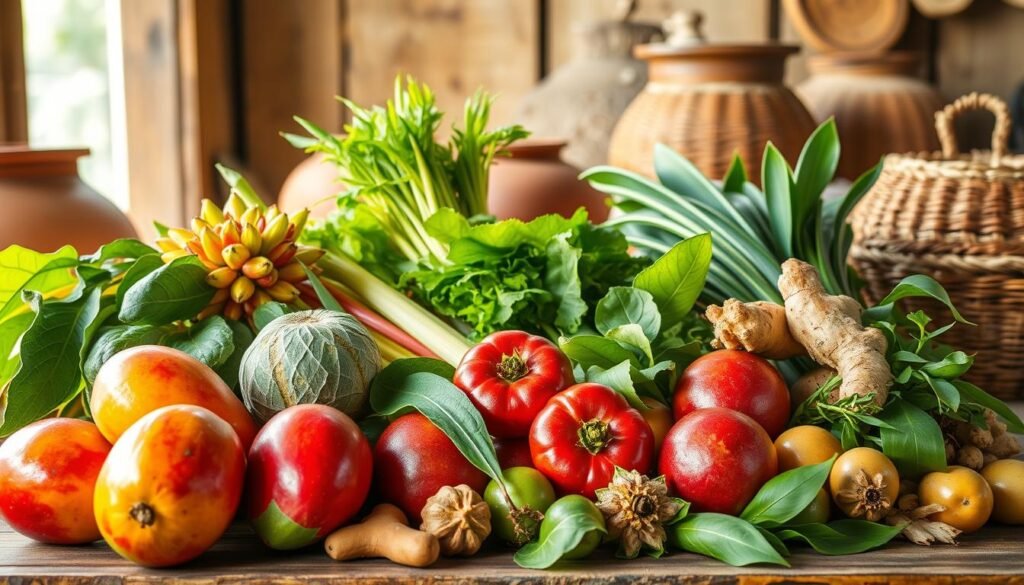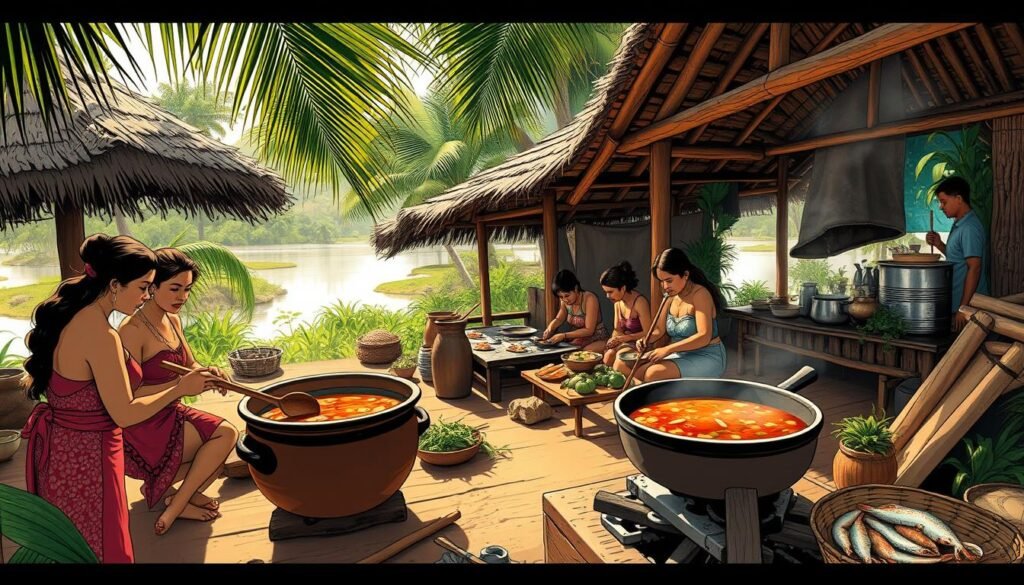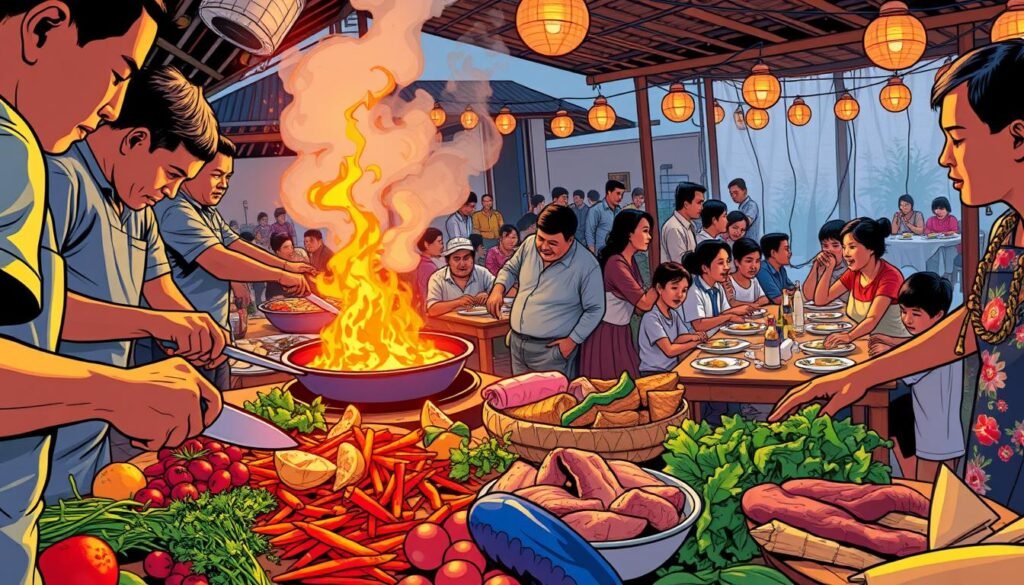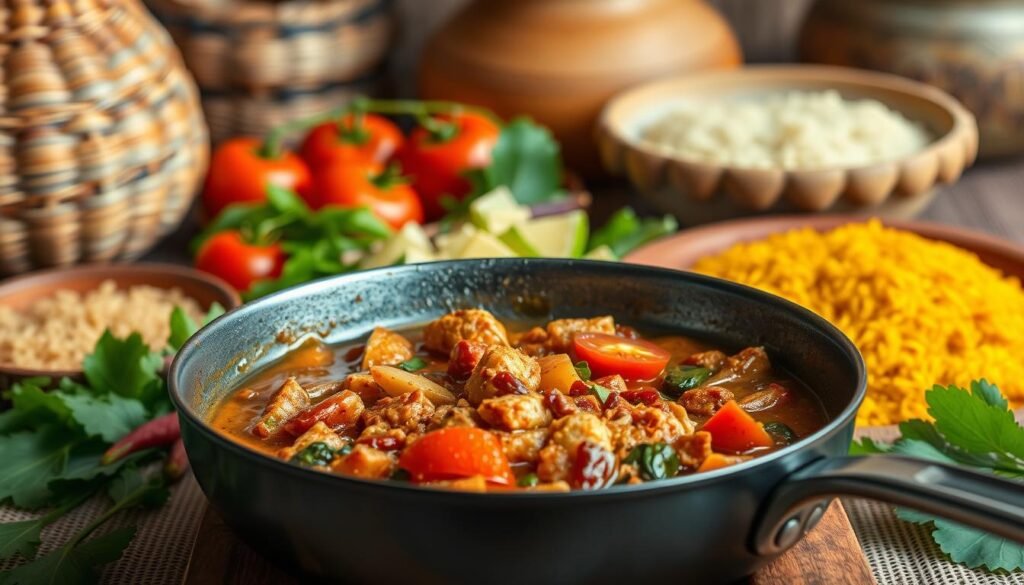Did you know that the Philippines, with over 7,000 islands, boasts one of the most diverse culinary traditions in the world? Ancient Filipino cuisine is a testament to the rich cultural heritage and resourcefulness of its people. Rooted in local traditions, it combines plant and animal sources to create dishes that are both nutritious and flavorful.
Key ingredients like grains, particularly rice, and vegetables have been staples for centuries. These elements, along with proteins from meat and seafood, formed the foundation of meals that sustained communities. Traditional cooking methods, such as boiling, roasting, and steaming, were not only practical but also preserved the natural flavors of the ingredients.
This article delves into the historical, cultural, and technical aspects of ancient Filipino cuisine. From the use of water and milk in recipes to the evolution of cooking techniques, we’ll explore how these practices shaped the nation’s culinary identity. Join us as we uncover the secrets behind these timeless dishes.
Key Takeaways
- Ancient Filipino cuisine reflects the diverse cultural heritage of the Philippines.
- Traditional ingredients include grains, vegetables, and animal products.
- Cooking methods like boiling and roasting preserved natural flavors.
- Rice is a staple, symbolizing prosperity and wealth.
- This article explores the historical and technical aspects of Filipino dishes.
History & Cultural Significance of Ancient Filipino Food
Ancient Filipino dishes tell a story of cultural evolution and environmental adaptation. Over centuries, the cuisine has been shaped by the interplay of local traditions and global influences. From pre-colonial practices to modern innovations, Filipino culinary traditions reflect the resilience and creativity of its people.
Evolution of Filipino Culinary Traditions
The roots of Filipino cuisine trace back to indigenous practices. Early communities relied on locally available plants and grains, with rice becoming a staple food. The arrival of Chinese settlers introduced noodles and soy sauce, while Spanish colonization brought tomatoes, garlic, and onions.
American influence in the 20th century added processed ingredients like canned meats and condiments. These diverse influences blended seamlessly with local flavors, creating a unique culinary identity. Today, dishes like adobo and sinigang remain symbols of this rich heritage.
Impact of Geography and Climate
The Philippines’ geography, with its 7,641 islands, played a crucial role in shaping its cuisine. Coastal areas relied heavily on seafood, while inland regions focused on meat and fruit from local farms. The tropical climate allowed for the cultivation of coconut, banana, and taro, which became essential ingredients.
Communal dining practices further emphasized the cultural significance of food. Meals were often shared during festivals and family gatherings, fostering a sense of community. This tradition continues today, highlighting the enduring role of food in Filipino culture.
Traditional Ingredients in Ancient Filipino Food
The foundation of ancient Filipino meals lies in the careful selection of local staples and grains. These ingredients not only provided sustenance but also shaped the cultural identity of communities across the archipelago.

Local Staples and Grains
Rice, corn, and wheat were the cornerstones of ancient Filipino diets. Rice, in particular, symbolized prosperity and was central to daily meals. Communities cultivated these grains using advanced agricultural techniques, like the Banaue rice terraces, which showcased their ingenuity.
These cereal products were versatile, used in everything from steamed rice to fermented beverages. Their abundance ensured food security and supported the growth of thriving settlements.
Use of Indigenous Fruits, Vegetables, and Herbs
The Philippines’ tropical climate allowed for a rich variety of fruits and vegetables. Coconut, banana, and taro were staples, while herbs like lemongrass and ginger added depth to dishes. These ingredients were not only flavorful but also packed with nutrients.
Seasonal harvests ensured a steady supply of fresh produce. This natural abundance allowed ancient Filipinos to create dishes that were both nourishing and deeply connected to their environment.
Ancient Filipino Cooking Methods
The cooking methods of ancient Filipinos were a blend of simplicity and ingenuity, using natural elements to create flavorful dishes. These techniques, passed down through generations, highlight the resourcefulness of early communities. From open fire grilling to steaming in earthen ovens, each method played a vital role in shaping the nation’s culinary identity.

Open Fire and Charcoal Techniques
Open fire and charcoal were central to ancient Filipino cooking. These methods allowed for direct heat application, perfect for grilling meat and seafood. The smoky flavor imparted by charcoal roasting became a signature of many traditional dishes.
Communities often gathered around the fire, turning cooking into a social event. This process not only prepared meals but also strengthened bonds among persons. The absence of modern appliances ensured a chemical-free approach, preserving the natural taste of ingredients.
Traditional Earthen Ovens and Steaming
Earthen ovens, known as “hurno,” were used for baking and slow-cooking. These ovens retained heat efficiently, allowing for even cooking. Steaming, often done with banana leaves, added aromatic flavors to dishes like suman and bibingka.
This system of cooking preserved nutrients while enhancing taste. The use of natural materials like clay and leaves showcased the sustainability of these methods. Even today, these techniques remain a testament to the ingenuity of ancient Filipinos.
| Method | Description | Example Dishes |
|---|---|---|
| Open Fire | Direct heat for grilling and roasting | Lechon, Inihaw na Baboy |
| Charcoal | Smoky flavor from burning charcoal | Isaw, Chicken Inasal |
| Earthen Oven | Slow-cooking in clay ovens | Bibingka, Lechon sa Hurno |
| Steaming | Using banana leaves for aromatic flavor | Suman, Puto |
These ancient methods not only created delicious meals but also reflected a deep connection to nature. By relying on simple tools and natural resources, early Filipinos developed a sustainable and flavorful culinary system.
The Influence of Nature on Filipino Cuisine
From fertile soil to pristine water sources, nature shaped ancient Filipino cuisine. The Philippines’ abundant natural resources provided the foundation for its unique culinary traditions. Clean water and nutrient-rich soil were essential for growing crops and preparing meals.

Role of Natural Water Sources and Soil
Water played a vital role in both irrigation and cooking. Rivers and springs were used to cultivate rice, the staple grain of Filipino meals. Communities relied on these sources for daily sustenance and food preparation.
Soil fertility was equally important. Rich volcanic soil allowed for the growth of indigenous crops like taro, coconut, and banana. These ingredients became staples, shaping the flavors of traditional dishes.
The interplay between the environment and agriculture was key to sustainability. Ancient Filipinos practiced crop rotation and used natural fertilizers to maintain soil health. This ensured a steady supply of fresh produce year-round.
Environmental changes, such as droughts or floods, impacted food availability. Communities adapted by diversifying crops and developing preservation techniques. This resilience highlights the deep connection between nature and culinary practices.
Examples of nature’s influence are evident in dishes like sinigang, which uses tamarind for its sour flavor, and bibingka, made from rice flour and coconut milk. These recipes showcase how natural resources shaped Filipino cuisine.
- Natural water sources supported irrigation and cooking.
- Fertile soil enabled the growth of indigenous crops.
- Sustainable practices ensured long-term food security.
- Environmental changes drove innovation in agriculture.
- Nature’s bounty inspired unique flavors and techniques.
The Philippines’ natural environment continues to influence its culinary identity. By honoring these traditions, we preserve a rich heritage rooted in the land and water.
Food: The Core of Filipino Culinary Identity
Filipino cuisine is more than just meals; it’s a reflection of shared values and traditions. From family gatherings to community feasts, the act of preparing and sharing dishes has always been a cornerstone of Filipino culture. These practices not only nourish the body but also strengthen bonds among persons.

Community and Ritual in Food Preparation
In the Philippines, cooking is often a communal activity. Families and neighbors come together to prepare meals, turning the process into a social event. This group effort fosters a sense of belonging and unity, making every dish a symbol of togetherness.
Traditional rituals also play a significant role. For example, during fiestas, entire villages collaborate to cook large quantities of lechon or adobo. These celebrations highlight the importance of food in bringing people together and preserving cultural heritage.
Health benefits are another key aspect. Dishes like sinigang and tinola are not only flavorful but also packed with nutrients. They are often served to those recovering from illness, showcasing the holistic approach to well-being in Filipino culture.
From communal feasts to ritual celebrations, Filipino culinary traditions emphasize the values of unity, health, and shared identity. These practices continue to shape the nation’s cultural landscape, making food a vital part of its heritage.
Ancient Techniques in Preserving Traditional Food
Preserving food was a vital skill for ancient Filipinos, ensuring survival during challenging times. With limited resources, communities developed methods to extend the shelf life of their meals. These techniques not only prevented spoilage but also ensured food security during off-seasons.

Fermentation and Smoking Processes
Fermentation was a common method to preserve ingredients like fish and vegetables. By using natural bacteria, ancient Filipinos created dishes like bagoong (fermented fish paste) and burong isda (fermented rice and fish). This process enhanced flavors and provided essential nutrients.
Smoking was another effective technique. Meats and fish were exposed to smoke from burning wood, which dried and preserved them. This method not only extended shelf life but also added a distinct smoky flavor, making dishes like tinapa (smoked fish) a staple in Filipino cuisine.
Salting and Drying Methods
Salting was a simple yet effective way to preserve food. By coating meats and fish with salt, ancient Filipinos removed moisture, preventing bacterial growth. This method was crucial for creating dishes like tuyo (dried fish), which could be stored for months.
Drying, often done under the sun, was another preservation technique. Fruits, vegetables, and even meats were dehydrated, reducing their weight and volume. This made them easier to transport and store, ensuring a steady supply of food during lean periods.
| Method | Description | Example Dishes |
|---|---|---|
| Fermentation | Using natural bacteria to preserve and enhance flavor | Bagoong, Burong Isda |
| Smoking | Exposing food to smoke for preservation and flavor | Tinapa, Smoked Meat |
| Salting | Coating food with salt to remove moisture | Tuyo, Salted Fish |
| Drying | Dehydrating food under the sun for long-term storage | Dried Mango, Tuyo |
These ancient preservation techniques were more than just practical solutions. They reflected the ingenuity and resourcefulness of early Filipinos, ensuring food security and continuity in their culinary traditions. Today, these methods continue to inspire modern practices, connecting the past to the present.
For more insights into ancient preservation techniques, explore how these methods have shaped culinary traditions worldwide.
The Role of Flavor and Taste in Ancient Filipino Cuisine
The art of balancing flavors has always been at the heart of ancient Filipino cuisine. Early cooks relied on locally available ingredients to create dishes that were both nutritious and delicious. By combining sweet, sour, and umami elements, they achieved a range of taste profiles that remain iconic today.

Natural compounds played a key role in shaping these flavors. For example, tamarind provided a tangy sourness, while coconut milk added a creamy sweetness. These ingredients were not only flavorful but also rich in nutrients, making them essential to daily meals.
Balancing Sweet, Sour, and Umami Elements
Ancient Filipino chefs mastered the delicate balance of flavors. Sweetness often came from fruit like mango or banana, while sourness was derived from tamarind or calamansi. Umami, the savory taste, was achieved through fermented products like bagoong (fish paste).
This interplay of flavors created dishes that were both complex and satisfying. For instance, sinigang, a sour soup, balances tamarind’s tang with the richness of pork or seafood. Similarly, adobo combines vinegar’s acidity with soy sauce’s umami for a savory-sour profile.
“The harmony of flavors in Filipino cuisine reflects the resourcefulness of its people and the richness of its natural resources.”
These traditional methods ensured a secure and balanced flavor profile, appealing to every person at the table. Without modern additives, ancient cooks relied on their deep understanding of ingredients to create wholesome meals.
| Flavor | Source | Example Dish |
|---|---|---|
| Sweet | Coconut milk, mango | Bibingka, Halo-Halo |
| Sour | Tamarind, calamansi | Sinigang, Kinilaw |
| Umami | Bagoong, soy sauce | Adobo, Kare-Kare |
This type of culinary artistry continues to inspire modern Filipino cooking. By honoring these ancient techniques, we preserve a rich heritage that celebrates the natural flavors of the Philippines. For more on how cultural exchanges shaped Filipino cuisine, explore the influences that have enriched its flavors over centuries.
Ingredient Sourcing and Local Agricultural Practices
Sustainable farming has long been a cornerstone of Filipino agricultural practices. Early communities relied on local resources to ensure a steady supply of fresh produce. By using methods like crop rotation and natural pest control, they maintained ecological balance while supporting their food production needs.

Sustainable Farming and Food Production
Traditional farming techniques in the Philippines focused on sustainability. Farmers cultivated crops like rice, coconut, and taro using methods that preserved soil health. Practices such as intercropping and reduced tillage minimized erosion and conserved water resources.
Local producers played a vital role in this system. They sourced ingredients within their communities, reducing the need for long-distance transportation. This approach not only ensured freshness but also supported the local economy.
Organizations like the food agriculture organization have further promoted sustainable practices. They provide training and resources to farmers, helping them adopt eco-friendly methods. This support has strengthened the connection between agriculture and environmental stewardship.
- Crop rotation and intercropping enhanced soil fertility.
- Natural pest control reduced reliance on synthetic chemicals.
- Local sourcing minimized transportation costs and carbon emissions.
- Community-supported programs ensured financial stability for farmers.
These practices ensured a steady supply of high-quality produce. By respecting the land and its resources, Filipino farmers created a sustainable system that continues to thrive today. For more on how these methods align with modern movements, explore the farm-to-table movement.
Nutritional Impact and Food Security in Historical Diets
Understanding the nutritional impact of ancient Filipino diets reveals how communities thrived despite limited resources. These diets were carefully crafted to provide essential nutrients, ensuring health and vitality across generations. From proteins to vitamins, every meal was designed to sustain life and promote growth.

Proteins played a crucial role in ancient Filipino meals. Sources like eggs, fish, and meat provided the building blocks for muscle development and repair. These ingredients were often paired with dairy products, such as coconut milk, to enhance flavor and nutritional value.
Balanced nutrition was key to sustaining life in early communities. Carbohydrates from rice and grains provided energy, while fruits and vegetables supplied essential vitamins. This combination ensured that every person received the nutrients needed for daily activities and long-term health.
Historical challenges, such as food scarcity, were met with innovative solutions. Communities preserved ingredients through drying and fermentation, ensuring a steady supply of food during lean periods. These practices not only addressed immediate needs but also laid the foundation for future food security.
Proper nutrition was especially vital for children. A diet rich in proteins and vitamins supported their growth and development, ensuring they reached their full potential. This focus on health at an early level contributed to the overall well-being of the community.
For more insights into the relationship between nutrition and food security, explore this detailed study on dietary patterns and their impact on health.
Modern Reflections on Ancient Filipino Culinary Traditions
The modern culinary scene in the Philippines is a vibrant blend of tradition and innovation. As global trends influence local practices, ancient cooking methods are being revived and reimagined. This fusion of old and new is not only preserving cultural heritage but also introducing Filipino cuisine to a wider audience.

Revival of Traditional Cooking Techniques
In recent years, there has been a renewed interest in traditional Filipino cooking methods. Techniques like open-fire grilling and steaming in banana leaves are making a comeback in modern kitchens. These methods, once essential for survival, are now celebrated for their ability to enhance natural flavors.
Chefs are also experimenting with ancient preservation techniques, such as fermentation and smoking. These practices not only add depth to dishes but also align with the growing demand for sustainable and organic food. For example, dishes like bagoong (fermented fish paste) and tinapa (smoked fish) are gaining popularity for their unique taste and nutritional value.
Contemporary Trends and Global Influences
Global culinary trends have significantly influenced modern Filipino cuisine. The rise of international food movements, like farm-to-table and fusion cooking, has inspired chefs to incorporate local ingredients into innovative recipes. This approach highlights the versatility of Filipino staples like coconut milk and indigenous fruit.
Organizations dedicated to food agriculture are also playing a crucial role in this revival. They promote sustainable farming practices and educate communities about the importance of preserving culinary heritage. These efforts ensure that traditional methods and ingredients remain accessible to future generations.
“The fusion of ancient techniques with modern innovation is redefining Filipino cuisine, making it a global culinary force.”
| Trend | Description | Example |
|---|---|---|
| Fusion Cooking | Combining Filipino flavors with international techniques | Adobo Tacos, Halo-Halo Cheesecake |
| Sustainability | Using locally sourced and organic ingredients | Farm-to-table Sinigang, Organic Lechon |
| Heritage Revival | Reintroducing ancient cooking methods | Smoked Tinapa, Fermented Bagoong |
This dynamic interplay between tradition and innovation is shaping the future of Filipino cuisine. By honoring the past while embracing the present, chefs and communities are ensuring that their culinary heritage remains vibrant and relevant. For more on how Filipino cooking reflects its history, explore this insightful article.
Conclusion
The rich tapestry of Filipino culinary heritage is a testament to the nation’s deep connection with its environment and traditions. From the use of indigenous fruit and grains to sustainable farming practices, ancient techniques have shaped a cuisine that is both nourishing and flavorful.
These methods, passed down through generations, highlight the ingenuity of early communities. Techniques like fermentation and open-fire grilling not only preserved food but also enhanced its taste. Today, these practices inspire modern chefs, blending tradition with innovation.
Nature has always played a pivotal role in Filipino cuisine. The fertile soil and abundant water sources allowed for the cultivation of essential ingredients. This harmony between the land and its people continues to influence culinary practices, ensuring a sustainable form of food production.
As we reflect on these traditions, it’s clear that change and continuity are both integral to the evolution of Filipino cuisine. By appreciating and preserving this heritage, we honor the cultural identity that sustains us. For more insights into the relationship between food and culture, explore this detailed study.
FAQ
What are some staple ingredients in ancient Filipino cuisine?
Ancient Filipino cuisine relied heavily on local staples like rice, corn, and root crops. Indigenous fruits, vegetables, and herbs such as taro, coconut, and lemongrass were also essential.
How did geography and climate influence Filipino culinary traditions?
The Philippines’ tropical climate and abundant natural resources shaped its culinary practices. Proximity to water sources led to a diet rich in seafood, while fertile soil supported diverse plant-based ingredients.
What cooking methods were commonly used in ancient Filipino kitchens?
Traditional methods included open fire and charcoal grilling, steaming, and using earthen ovens. These techniques preserved the natural flavors of ingredients.
How did ancient Filipinos preserve their food?
Preservation techniques included fermentation, smoking, salting, and drying. These methods ensured food security and extended the shelf life of perishable items.
What role did community play in Filipino food preparation?
Food preparation was a communal activity, often tied to rituals and celebrations. It strengthened social bonds and passed down culinary knowledge through generations.
How did ancient Filipino cuisine balance flavors?
Traditional dishes emphasized a balance of sweet, sour, and umami flavors. Ingredients like vinegar, tamarind, and fish sauce were commonly used to achieve this harmony.
What impact did ancient Filipino diets have on nutrition and health?
Diets rich in grains, vegetables, and protein sources like fish provided essential nutrients. These practices contributed to food security and overall well-being.
How are ancient Filipino culinary traditions being revived today?
Modern chefs and food enthusiasts are reviving traditional techniques and ingredients. This movement highlights the cultural significance of Filipino cuisine in a global context.
What sustainable practices were used in ancient Filipino agriculture?
Farmers employed methods like crop rotation and organic fertilization. These practices ensured long-term soil health and sustainable food production.
How has global influence shaped contemporary Filipino cuisine?
While traditional elements remain, global trends have introduced new ingredients and techniques. This fusion creates a dynamic and evolving culinary landscape.
Source Links
- Filipino Food 101: Recipes to Get You Started
- Filipino Food Cooking Techniques
- History of the Philippines & its Food: A Timeline — The World in a Pocket
- Food Culture of the Philippines: Exploring Filipino Cuisine | Discover by Silversea
- The Story of Filipino Cuisine: A Culinary Journey Through History
- Filipino cuisine
- Detailed Guide to Local Cuisine of the Philippines: Traditional Filipino Food & Delicacies | Guide to the Philippines
- Filipino food: a cuisine of many influences
- 11 traditional Filipino cooking techniques that aren’t adobo and sinigang
- Traditional Filipino Cooking Methods
- American Influence On Filipino Food – Episode Transcript — Exploring Filipino Kitchens
- The Heart of Filipino Food Culture Revealed
- Filipino Cuisine: A Rich Tapestry Of Culinary Traditions
- Eat, Pray, Heal: The Connection Between Filipino Cuisine and Wellness –
- Chef Nicole Ponseca is elevating Filipino cuisine to new heights
- The history of preserving food at home
- History of Food Preservation | Ancient Food Storage & The History of Preserving Food
- Flavours of the Philippines – Nourish & Tempt
- Filipino Cuisine: An Underrated Culinary Gem
- Filipino cuisine isn’t as well-known as other Asian foods — but that’s changing
- Sustainable Nutrition | MealVillage
- From Farm to Table: The Benefits of Sourcing Local Ingredients for Your Restaurant
- Sustainable sourcing: The biggest trends defining an evolving process
- Understanding the Impact of Historical Policy Legacies on Nutrition Policy Space: Economic Policy Agendas and Current Food Policy Paradigms in Ghana
- What is Food Security? There are Four Dimensions
- Filipino Cooking As A Reflection of Filipino History
- How Chef Tatung Sarthou is merging traditional and contemporary Filipino cuisine
- Conclusions and Recommendations – Food Components to Enhance Performance
- Conclusions
- Conclusion: Choice and necessity – Food and Society in Classical Antiquity

